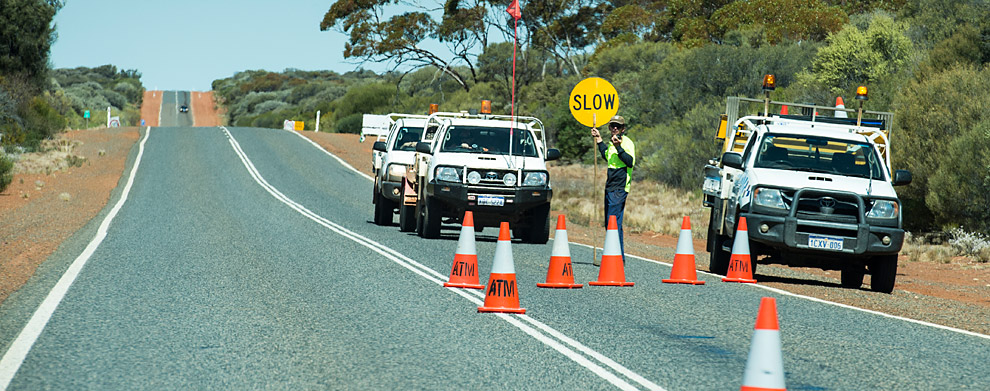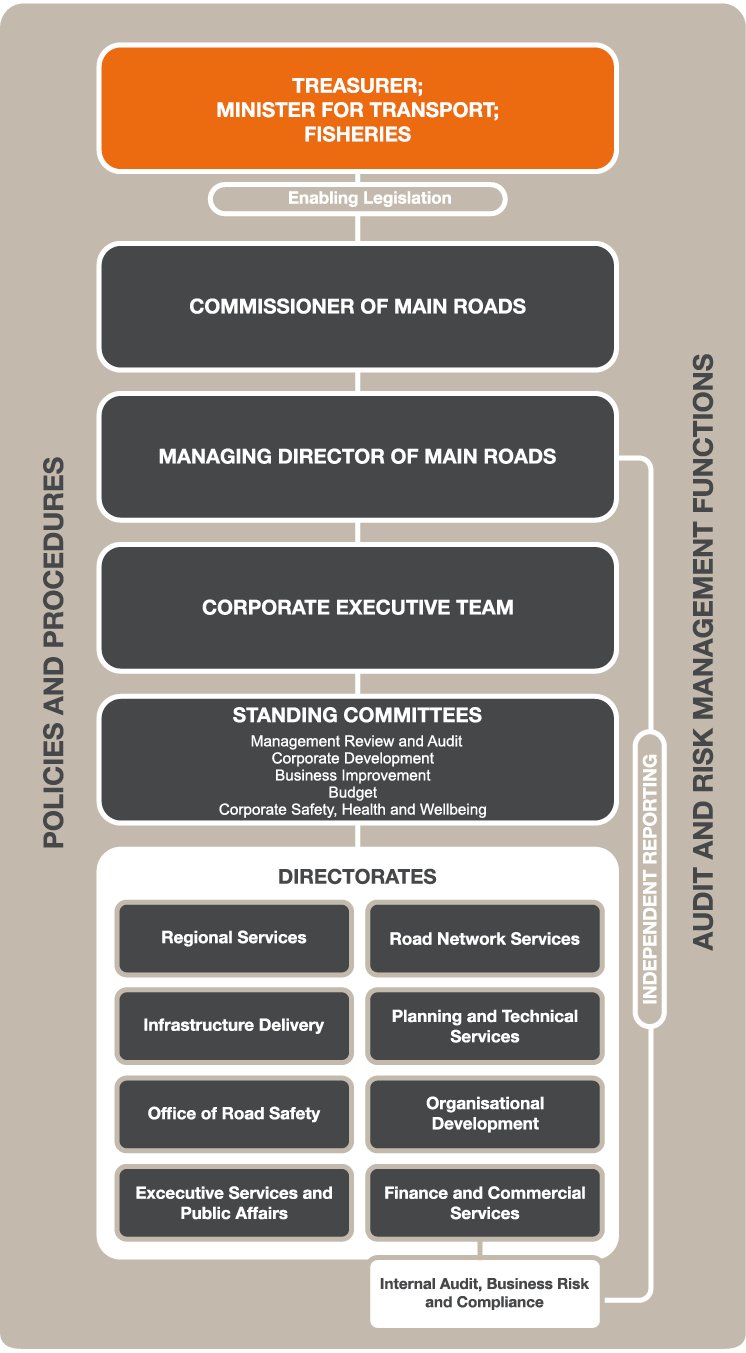
Principle 2 & 3: Management and Oversight and Our Organisational Structure
Strategic Plan
Our current Strategic Plan, known as 2k12, sets the high-level strategic direction for our organisation up to the end of 2012. This five-year improvement plan has served us well and seen a range of significant improvements deployed across the organization. It drove us as we sought to ‘achieve excellence through inspiring leadership and strong collaborative relationships’. The existing Strategic Plan was built around and focused on delivering the following five Strategic Areas of Focus:
Strategic Area of Focus |
Objective |
Providing the right roads for WA |
Planning, developing and delivering effective outcome-based road programs |
Making roads work for the community |
Ensuring people and freight can move safely, reliably and efficiently across the road network |
Creating our workforce of the future |
Creating an environment that will attract, develop and retain employees |
Inspiring leadership |
Creating an environment that develops and recognises leadership throughout the organisation |
Enhancing relationships |
Enhancing existing and forging new relationships |
Our new Strategic Plan, to be known as 2020, has now been fully developed and will be rolled out across the organisation in mid-2013. In developing our new plan we have once again used scenario planning to capture a variety of economic, social, political and technological trends that have the potential to impact on the business. Following extensive internal engagement with our Portfolio partners, employees, suppliers and customers, we have created a new Vision and, Purpose and identified new areas of focus to guide us in the coming years. The latest information on the Plan is available on our website.
We discuss how our Corporate Business Plan keeps track and measures our performance in alignment with our Strategic Plan in Principle 4.
Delegation of Authority
Our Delegation of Authority Manual exists to clearly define the administrative responsibilities of officers and give them sufficient authority to carry out their day-to-day tasks. The Delegation of Authority is in accordance with the Main Roads Act 1930 and the principle of public administration set out in Section 7(d) of the Public Sector Management Act 1994. Employees are aware that delegation limits are specified in the Manual and that they must not be exceeded.
Corporate Executive
Corporate Executive comprises the Managing Director, all Executive Directors and the Manager Executive Services. Corporate Executive’s objectives are to set clear strategic direction to deliver Government priorities, meet our purpose and achieve defined performance goals. It meets monthly to review organisational performance both directly and through a series of formally established sub-committees. Eleven Corporate Executive meetings were held in the last financial year and attendance is shown below.
Corporate Executive Member |
Attended Meetings |
Menno Henneveld, Managing Director to December 2012 |
5 |
Steve Troughton, Managing Director from February 2013 |
5 |
John Erceg, Executive Director Regional Services |
11 |
Des Snook, Executive Director Road Network Services |
10 |
Leo Coci, Executive Director Infrastructure Delivery |
11 |
Peter Woronzow, Executive Director Finance & Commercial Services |
11 |
John Taya, Executive Director Organisational Development |
11 |
Doug Morgan, Executive Director Planning & Technical Services |
11 |
Iain Cameron, Executive Director Office of Road Safety |
10 |
Steve Potter, A/Manager Executive Services |
11 |
The position of Managing Director was held by Menno Henneveld to December 2012. Our new Managing Director, Steve Troughton was appointed in February 2013. In the absence of a Managing Director, our Commissioner, Reece Waldock chaired the meetings. Due to a minor organisational restructure, the position of Director Budget and Financial Planning and Director of Strategic Relationships no longer form part of the Corporate Executive team.
Corporate Executive’s role is to:
- Assist in discharging the Managing Director’s responsibilities and to operate as an advisory body to the Managing Director.
- Achieve the best outcomes from strategic decisions; garner Executive commitment to organisational priorities; and model Main Roads’ values and behaviours to the organisation.
- Set strategy, oversight, decision-making, leadership, manage organisational performance and ensure capability to deliver road user services.
- Provide a forum to raise issues of corporate relevance and seek the feedback and input of peers.
- Be proactive, oriented to the long term, and outcomes-focused.
In achieving its role, Corporate Executive is supported by five standing committees. Each committee is led by a member of Corporate Executive and reports regularly on its achievements and future direction. These committees provide a mechanism for staff to provide recommendations and direction to Corporate Executive for activities within their function. A table below summaries the main activities undertaken by each committee during the year, membership of the committee, and attendance by relevant Corporate Executive members.
Our Governance Model and Organisational Structure

Standing Committees’ 2012-13 Role and Achievements
Corporate Development Committee Meetings Held: 8 |
||
Membership (Attendance) |
Committee Role |
2012-13 Achievements |
Executive Members:John Taya (Chair) – 6 John Erceg – 7 Des Snook – 3 Leo Coci – 8 Peter Woronzow – 8 Doug Morgan – 8 There are 2 other non-executive standing members in this committee. |
|
|
Business Improvement Committee Meetings Held: 4 |
||
Executive Members:Peter Woronzow (Chair) – 4 John Erceg – 4 John Taya – 2 Doug Morgan – 2 There are 3 other non-executive standing members in this committee. |
|
|
Management Review and Audit Committee Meetings Held: 3 |
||
Executive Members:Menno Heneveld – 1 (chair to December 2012) Steve Troughton – 1 (chair from February 2013) Peter Woronzow – 3 Doug Morgan – 3 |
|
|
Budget Committee Meetings Held: 12 |
||
Executive Members:Peter Woronzow (Chair) – 11 John Erceg – 11 Des Snook – 10 Leo Coci – 12 Doug Morgan – 11 John Taya – 8 |
|
|
Corporate Safety, Health and Wellbeing Committee Meetings Held: 9 |
||
Executive Members:Doug Morgan (Chair) – 9 John Erceg – 8 Des Snook – 4 Leo Coci – 8 Peter Woronzow – 7 John Taya – 7 Iain Cameron – 7 There are 10 other non-executive standing members in this committee. |
|
|


